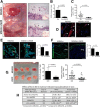A novel role for ezrin in breast cancer angio/lymphangiogenesis
- PMID: 25231728
- PMCID: PMC4303119
- DOI: 10.1186/s13058-014-0438-2
A novel role for ezrin in breast cancer angio/lymphangiogenesis
Erratum in
-
Erratum to: "A novel role for ezrin in breast cancer angio/lymphangiogenesis".Breast Cancer Res. 2015 Jan 23;17(1):9. doi: 10.1186/s13058-014-0511-x. Breast Cancer Res. 2015. PMID: 25848816 Free PMC article. No abstract available.
Abstract
Introduction: Recent evidence suggests that tumour lymphangiogenesis promotes lymph node metastasis, a major prognostic factor for survival of breast cancer patients. However, signaling mechanisms involved in tumour-induced lymphangiogenesis remain poorly understood. The expression of ezrin, a membrane cytoskeletal crosslinker and Src substrate, correlates with poor outcome in a diversity of cancers including breast. Furthermore, ezrin is essential in experimental invasion and metastasis models of breast cancer. Ezrin acts cooperatively with Src in the regulation of the Src-induced malignant phenotype and metastasis. However, it remains unclear if ezrin plays a role in Src-induced tumour angio/lymphangiogenesis.
Methods: The effects of ezrin knockdown and mutation on angio/lymphangiogenic potential of human MDA-MB-231 and mouse AC2M2 mammary carcinoma cell lines were examined in the presence of constitutively active or wild-type (WT) Src. In vitro assays using primary human lymphatic endothelial cells (hLEC), an ex vivo aortic ring assay, and in vivo tumour engraftment were utilized to assess angio/lymphangiogenic activity of cancer cells.
Results: Ezrin-deficient cells expressing activated Src displayed significant reduction in endothelial cell branching in the aortic ring assay in addition to reduced hLEC migration, tube formation, and permeability compared to the controls. Intravital imaging and microvessel density (MVD) analysis of tumour xenografts revealed significant reductions in tumour-induced angio/lymphangiogenesis in ezrin-deficient cells when compared to the WT or activated Src-expressing cells. Moreover, syngeneic tumours derived from ezrin-deficient or Y477F ezrin-expressing (non-phosphorylatable by Src) AC2M2 cells further confirmed the xenograft results. Immunoblotting analysis provided a link between ezrin expression and a key angio/lymphangiogenesis signaling pathway by revealing that ezrin regulates Stat3 activation, VEGF-A/-C and IL-6 expression in breast cancer cell lines. Furthermore, high expression of ezrin in human breast tumours significantly correlated with elevated Src expression and the presence of lymphovascular invasion.
Conclusions: The results describe a novel function for ezrin in the regulation of tumour-induced angio/lymphangiogenesis promoted by Src in breast cancer. The combination of Src/ezrin might prove to be a beneficial prognostic/predictive biomarker for early-stage metastatic breast cancer.
Figures






Similar articles
-
Ezrin phosphorylation on tyrosine 477 regulates invasion and metastasis of breast cancer cells.BMC Cancer. 2012 Mar 7;12:82. doi: 10.1186/1471-2407-12-82. BMC Cancer. 2012. PMID: 22397367 Free PMC article.
-
Prognostic significance of vascular endothelial cell growth factors -A, -C and -D in breast cancer and their relationship with angio- and lymphangiogenesis.Br J Cancer. 2007 Apr 10;96(7):1092-100. doi: 10.1038/sj.bjc.6603678. Epub 2007 Mar 13. Br J Cancer. 2007. PMID: 17353919 Free PMC article.
-
The membrane cytoskeletal crosslinker ezrin is required for metastasis of breast carcinoma cells.Breast Cancer Res. 2005;7(3):R365-73. doi: 10.1186/bcr1006. Epub 2005 Mar 21. Breast Cancer Res. 2005. PMID: 15987432 Free PMC article.
-
Prostanoids Regulate Angiogenesis and Lymphangiogenesis in Pathological Conditions.Cold Spring Harb Perspect Med. 2024 Dec 2;14(12):a041182. doi: 10.1101/cshperspect.a041182. Cold Spring Harb Perspect Med. 2024. PMID: 38565267 Review.
-
Endothelial adhesion molecules in breast cancer invasion into the vascular and lymphatic systems.Eur J Surg Oncol. 2005 Oct;31(8):824-32. doi: 10.1016/j.ejso.2005.05.015. Eur J Surg Oncol. 2005. PMID: 16055299 Review.
Cited by
-
Combination of SIRT1 and Src overexpression suggests poor prognosis in luminal breast cancer.Onco Targets Ther. 2018 Apr 11;11:2051-2061. doi: 10.2147/OTT.S162503. eCollection 2018. Onco Targets Ther. 2018. PMID: 29695913 Free PMC article.
-
Erratum to: "A novel role for ezrin in breast cancer angio/lymphangiogenesis".Breast Cancer Res. 2015 Jan 23;17(1):9. doi: 10.1186/s13058-014-0511-x. Breast Cancer Res. 2015. PMID: 25848816 Free PMC article. No abstract available.
-
miR-205-3p promotes proliferation and reduces apoptosis of breast cancer MCF-7 cells and is associated with poor prognosis of breast cancer patients.J Clin Lab Anal. 2019 Oct;33(8):e22966. doi: 10.1002/jcla.22966. Epub 2019 Oct 2. J Clin Lab Anal. 2019. PMID: 31578772 Free PMC article.
-
Ezrin, more than a metastatic detERMinant?Oncotarget. 2019 Nov 26;10(63):6755-6757. doi: 10.18632/oncotarget.27227. eCollection 2019 Nov 26. Oncotarget. 2019. PMID: 31827718 Free PMC article. No abstract available.
-
Cytoskeletal Remodeling in Cancer.Biology (Basel). 2020 Nov 7;9(11):385. doi: 10.3390/biology9110385. Biology (Basel). 2020. PMID: 33171868 Free PMC article. Review.
References
-
- Bruce B, Khanna G, Ren L, Landberg G, Jirstrom K, Powell C, Borczuk A, Keller ET, Wojno KJ, Meltzer P, Baird K, McClatchey A, Bretscher A, Hewitt SM, Khanna C. Expression of the cytoskeleton linker protein ezrin in human cancers. Clin Exp Metastasis. 2007;24:69–78. doi: 10.1007/s10585-006-9050-x. - DOI - PubMed
Publication types
MeSH terms
Substances
Grants and funding
LinkOut - more resources
Full Text Sources
Other Literature Sources
Medical
Molecular Biology Databases
Miscellaneous

